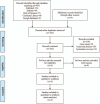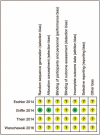Is dynamic locking plate superior than other implants for intracapsular hip fracture: A meta-analysis
- PMID: 30461606
- PMCID: PMC6392746
- DOI: 10.1097/MD.0000000000013001
Is dynamic locking plate superior than other implants for intracapsular hip fracture: A meta-analysis
Abstract
Background: We studied the safety and efficacy of dynamic locking plate vs. other implants (cannulated cancellous screws [CCS] or sliding hip screw [SHS]) in patients undergoing intracapsular hip fracture (ICHF).
Methods: We searched Pubmed, Embase, Web of Science, Cochrane library and Google database from inception to March 25, 2018. We selected any studies comparing dynamic locking plate for treatment ICHF. Non-union rate, osteonecrosis rate, cutout rate, revision rate, the replacement rate, and Harris hip scores were the outcomes. Stata 12.0 was used for meta-analysis.
Results: Four studies involving 419 patients (143 patients in the dynamic locking plate group and 276 patients in the other implants group) were finally included. Compared with CCS or SHS, dynamic locking plate was associated with a reduction of nonunion rate, revision rate, replacement rate (P <.05). Furthermore, dynamic locking plate was also associated with an increase of the Harris hip scores (P <.05). There was no significant difference between the osteonecrosis rate and cutout rate (P >.05).
Conclusions: Current meta-analysis revealed that dynamic locking plate has a benefit role in improving postoperative clinical outcome than CCS or SHS in ICHF patients. Further high quality and large-scale randomized controlled trials (RCTs) are needed to further identify the efficacy of dynamic locking plate for ICHF.
Conflict of interest statement
The authors have no conflicts of interest to disclose.
Figures









Similar articles
-
Is dynamic locking plate(Targon FN) a better choice for treating of intracapsular hip fracture? A meta-analysis.Int J Surg. 2018 Apr;52:30-34. doi: 10.1016/j.ijsu.2018.01.044. Epub 2018 Feb 7. Int J Surg. 2018. PMID: 29427750 Review.
-
Dynamic locking plate vs. simple cannulated screws for nondisplaced intracapsular hip fracture: A comparative study.Injury. 2016 Feb;47(2):424-7. doi: 10.1016/j.injury.2015.10.054. Epub 2015 Oct 30. Injury. 2016. PMID: 26612475
-
Comparison of early complications between the use of a cannulated screw locking plate and multiple cancellous screws in the treatment of displaced intracapsular hip fractures in young adults: a randomized controlled clinical trial.J Orthop Surg Res. 2018 Aug 13;13(1):201. doi: 10.1186/s13018-018-0901-3. J Orthop Surg Res. 2018. PMID: 30103792 Free PMC article. Clinical Trial.
-
The outcome of intracapsular hip fracture fixation using the Targon Femoral Neck (TFN) locking plate system or cannulated cancellous screws: A comparative study involving 2004 patients.Injury. 2017 Nov;48(11):2555-2562. doi: 10.1016/j.injury.2017.08.063. Epub 2017 Sep 1. Injury. 2017. PMID: 28918874
-
Sliding hip screws versus cancellous screws for femoral neck fractures: a systematic review and meta-analysis.Eur J Orthop Surg Traumatol. 2019 Oct;29(7):1383-1393. doi: 10.1007/s00590-019-02460-0. Epub 2019 Jun 5. Eur J Orthop Surg Traumatol. 2019. PMID: 31165917
Cited by
-
Dynamic Locking Plate versus Multiple Cancellous Screws for the Fixation of Intracapsular Femoral Neck Fractures: Long-Term Results and Quality-Of-Life Assessment Based on Patient-Reported Outcome Measures.J Clin Med. 2024 Feb 16;13(4):1123. doi: 10.3390/jcm13041123. J Clin Med. 2024. PMID: 38398436 Free PMC article.
-
Outcomes of Headed and Headless Cannulated Screws Fixation in Nondisplaced Femoral Neck Fracture.Geriatr Orthop Surg Rehabil. 2025 Apr 9;16:21514593251330580. doi: 10.1177/21514593251330580. eCollection 2025. Geriatr Orthop Surg Rehabil. 2025. PMID: 40292380 Free PMC article.
-
Dynamic hip screws versus cannulated screws for femoral neck fractures: a systematic review and meta-analysis.J Orthop Surg Res. 2020 Aug 26;15(1):352. doi: 10.1186/s13018-020-01842-z. J Orthop Surg Res. 2020. PMID: 32843048 Free PMC article.
References
-
- Holt G, Smith R, Duncan K, et al. Gender differences in epidemiology and outcome after hip fracture: evidence from the Scottish Hip Fracture Audit. J Bone Joint Surg Br 2008;90:480–3. - PubMed
-
- Holt G, Smith R, Duncan K, et al. Epidemiology and outcome after hip fracture in the under 65s-evidence from the Scottish Hip Fracture Audit. Injury 2008;39:1175–81. - PubMed
-
- Cooper C, Campion G, Melton LJ., 3rd Hip fractures in the elderly: a world-wide projection. Osteoporos Int 1992;2:285–9. - PubMed
Publication types
MeSH terms
LinkOut - more resources
Full Text Sources
Medical

